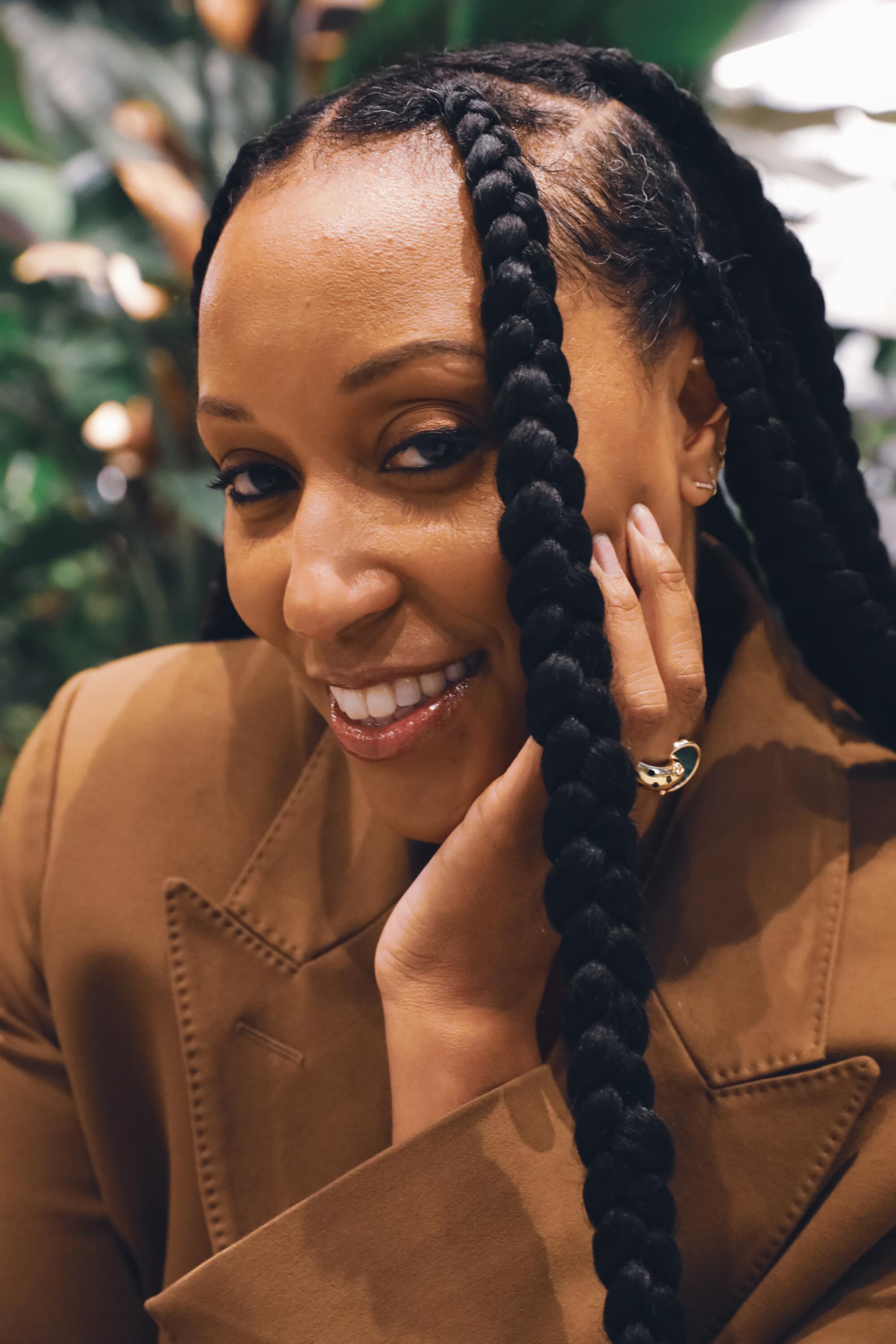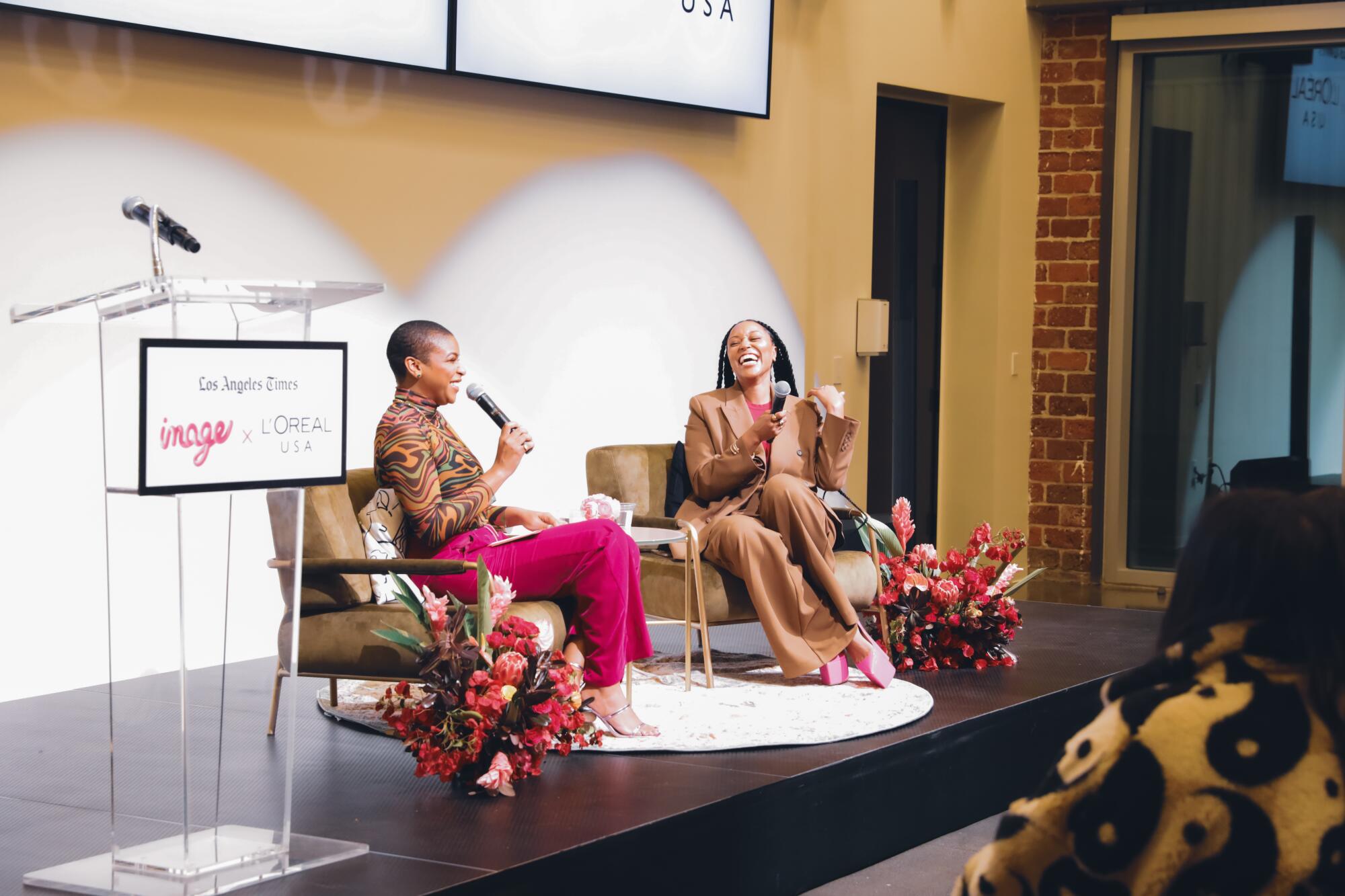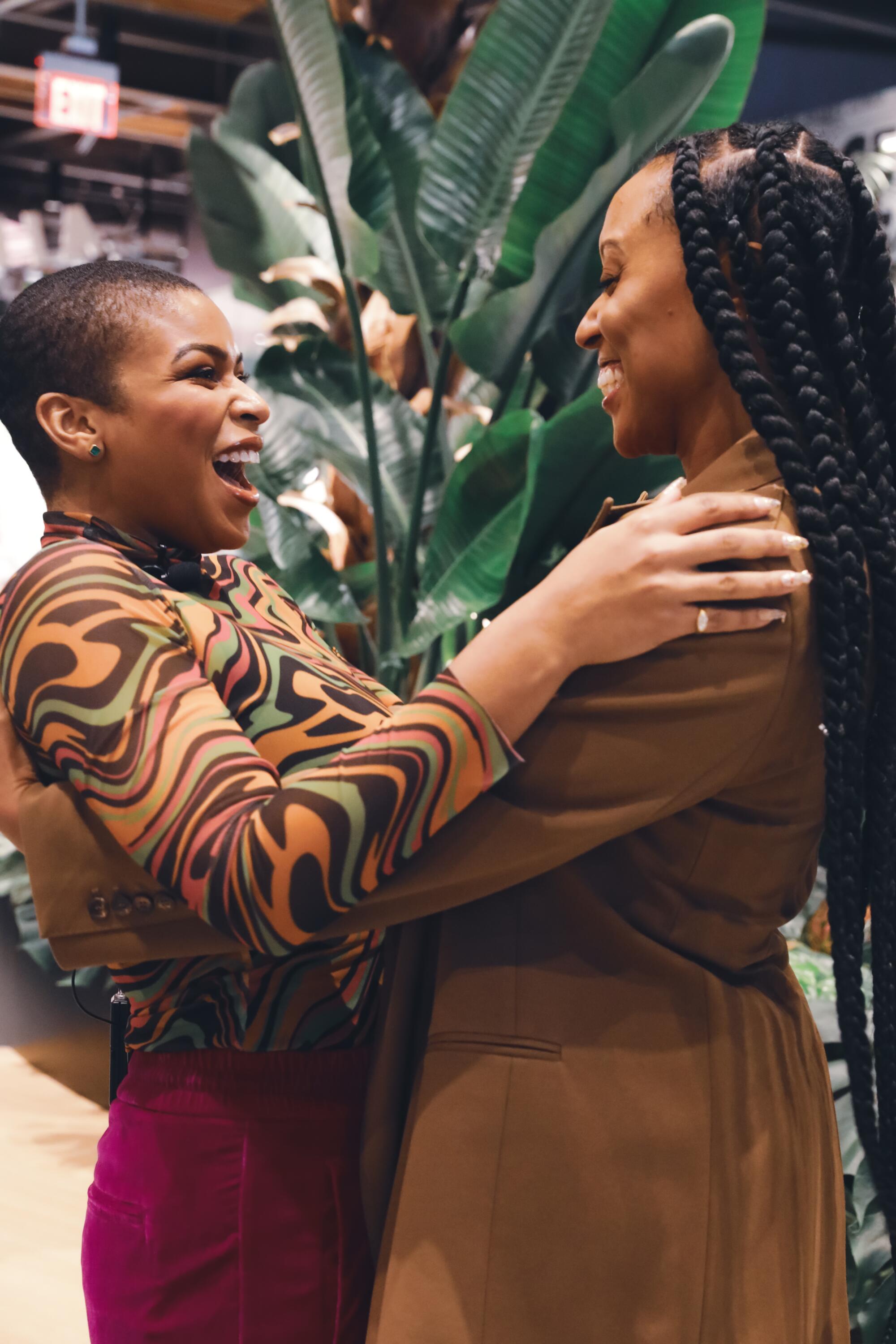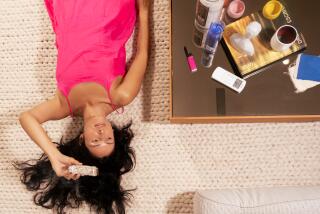- Share via

“I don’t do a lot of celebrity styling — it’s something that I enjoy in small doses,” Shiona Turini told Darian Symoné Harvin at an Image magazine and L’Oréal event in El Segundo last November. Turini had just gotten back from a press tour with the “Black Panther: Wakanda Forever” cast. Styling Letitia Wright, Turini explained, has felt different and meaningful.
“I want to make sure that someone feels like they’re facing the world the best way they can and in an authentic way. That is a level of responsibility that I take seriously,” Turini said of her styling work. It’s why she doesn’t take that many clients at a time.
The night had the feel of “a dinner table conversation,” as Harvin put it, as the two women have been friends for several years. Below is an edited version of the conversation, which dives into how Turini got into styling, her early inspirations and her philosophy on including the communities she represents in her work.
Darian Symoné Harvin: Why did you decide to collaborate with Letitia Wright specifically on this project with “Black Panther: Wakanda Forever”? I’ve always been very curious about that initial interaction. What are you looking to learn about that person?
Shiona Turini: That’s a good question. I do not take every client that comes my way, as you know, because it’s my energy — my energy is my time, my talent. The vibe has to be right. So, they [the “Black Panther” team] just emailed me. I had a costume designer job in Baltimore, [and] I didn’t know if this was a project that I could put my all into. But when I logged into the Zoom, something unique happened in that everyone was a Black female. I have had a lot of calls and meetings with people, and they’re very Black girl magic in the streets, and then it’s a whole white team behind them, which is fine, but that struck a chord for me to see a publicist, the assistant — like everybody on the team — a Black female.
It’s been a beautiful thing [working with Letitia], because I feel like actors in general have to develop in front of the camera, and being a part of her evolution into who she feels like in this moment is very special.

DSH: The clothes, to me, feel like an extension of Letitia’s energy, in the sense that you can tell she’s very proud to be who she is.
ST: One important thing that I’ve always asked anyone I work with is not “What do you want to look like,” but, “Show me pictures of when you hated how you looked.” I always want to know: When did you not feel like yourself? A lot of times actors are doing what they’re told — I cannot work with people like that. I really like to work with people who are intentional and have a point of view, which I know some stylists do not like but I do because I want everything to feel like a collaboration. I never want someone to feel like I forced them to wear something, because they’re the ones that have to live with that picture.
DSH: What you’re bringing up — and correct me if I’m wrong — is that in being a stylist, you’re recognizing that you might have a vision, but it’s actually not about you.
ST: There is not one crop top in sight [in “Black Panther: Wakanda Forever”]. I would love to make it happen — but that’s not [Letitia]. I don’t want her to feel uncomfortable, I don’t want her to feel self-conscious. I want to make sure that when she goes out on the red carpet, or when she goes to an event, that she feels 100% authentically herself and the best version of herself. That’s my job.
DSH: I want to talk about how you ended up here in L.A. What was the job?
ST: I was working in magazines for a very long time in New York. I was at Vogue, W, Cosmo, and I had reached a point where I was like, I can go to another magazine, but it’s almost the same process, just a different audience. I don’t want to just continue to jump from publication to publication. I don’t want to be an editor in chief. I kind of was at a crossroads in my career. How do I tell stories through clothes, but in a different way? [This is] kind of random, but I ended up in India and stayed for a month (I like to do a lot of solo travel that I can’t do with other people). While I was there, I was thinking a lot about my next steps, and maybe a week after I got back, I got a phone call [asking me if I] ever considered costume design [and if I] would consider costume designing “Insecure.”
I love “Insecure.” It’s very strange to be approached to work on something that you admire so much because it can take some of the magic out of it. I thought a lot about it — I’ve never done costume design before, but I’m sure I can see this. That’s how I’ve moved through a lot of my career: I’ve never done that before, but I can see a way. I had to move to L.A. [for the job], which I was not excited about. One of the beautiful things about “Insecure” is that there are four main characters and the fifth is L.A. I had to not just do a deep dive in costume design but a deep dive in Los Angeles and how people dress. I remember just going to a coffee shop and watching people be, because it’s different from New York — I spent 15 years in New York building my career — and so now I was here, I wanted to make sure that it was as authentic as possible.
DSH: I’m curious how do you research. I’m thinking even about the new movie that you just came off of set for — there was a research process that I watched you go through. Could you share all the nitty gritty details?
ST: Well, number one, I’m a Virgo. And so much of my work — even before I became a costume designer, I didn’t fully grasp how much research goes into the actual projects. The job that [you’re] referencing is my first period, and it is 1960s Baltimore. I think that I was pretty well versed in 1960s L.A. or New York — very fashion-forward places. But this is a city that was super impactful and forward when it came to civil rights, but maybe a couple years behind New York or L.A. and definitely London [in terms of fashion], because when people think of the ‘60s — or someone who works in fashion thinks of the ‘60s — you think of Twiggy, miniskirts, things like that. But the Black community in Baltimore — they were at church. They were not about that life. I spent probably three months [doing research and] started at the costume houses [which] all have libraries. I ordered all of the Jet magazines, the fashion magazines, to just get an understanding of, globally, what style was at that time. But then I went to the costume houses because they have actual department store archives — I actually drilled into all of the department store catalogs to see what women were actually buying. And it was very different. And so, for this project, I like to call it “period-ish” —
DSH: With your own spin.
ST: Yeah, because I still wanted it to feel a little bit like it’s TV. You want to dream a little bit; you want to watch TV and you want to feed into the fantasy. So I tried to find that happy medium.
DSH: When you are on set, what does your collaboration with beauty or with hair and makeup look like?
ST: You can’t do one without the other. Usually, I’ll go through my mood boards with the hair and makeup teams, and they can get an idea of what I’m thinking for clothing. It might be a scene that specifically calls out the glam moment in hair and makeup and then I’ll go to them [and ask what they’re] thinking [for a] hairstyle. People on set find it to be annoying, but I cannot decide jewelry until I know what the hair is. Because I don’t want earrings to compete with the hair and I feel like hair, especially on the projects I’ve worked with, is an accessory within itself. I don’t want my earring choice to be fighting against the hairstyle; I want to make sure that the hairstyle can have a time to shine.
DSH: Growing up, did you feel beautiful?

ST: That’s a really good question. There were probably moments where I was like, “I am not cute.” I had a very awkward stage with the braces and not being able to control my hair. Having a mother that’s like, “This is how you’re gonna be.” But I was also very rebellious. I remember my mom was like, “You can’t dye your hair,” and I just walked to the beach and dyed my hair blond, and I looked terrible. I hated it because my mom was right. She helped me fix it.
DSH: In evolving, getting older, how do you feel that your upbringing has influenced your approach to beauty now?
ST: I was surrounded by very stylish women and that’s where my love of fashion came from. My godmother, who’s also my aunt, taught me how to sew at a very young age. My mom [is] super stylish. I would always watch her getting ready, especially getting ready for church — they still have a hat fashion show at the church in the front row. I feel like I was very blessed by being surrounded by women [who] authentically had style. None of them wore a lot of makeup, but one thing that I do love about my family is that no one straightens their hair. I went through a period where I always straightened my hair, but they all just wear their hair natural and that has taught me a lot about trying to wear my hair natural, deal with my curls and learn more about my curls. I get a lot of beauty tips from my family still.
DSH: What do you look for when it comes to collaborating with a beauty brand? And what do you need in order to pull off and achieve the photography, the video, the content that you want on your page?
ST: Well, number one, I’m extra. My managers are like, “Can’t you just take a mirror selfie and move along?” And I’m like, absolutely not. But for beauty partnerships, I don’t partner with any brands that I don’t actually use. That has always been very important to me. It doesn’t matter what the check looks like, if I don’t authentically use that product, or if I wouldn’t go buy it with my own money, I’m not going to partner with them because I don’t want to sell something or put my name behind something that I actually don’t believe in.
As far as the content, I’m sure I make everyone crazy because, like I said, I’m extra. I want it to be something that’s engaging and entertaining and something that I want to see. My background as being an editor means that I always want to see something that feels a little bit different than what someone else is doing or what I’ve done before. So, I actually take the time to, like, create and structure my content.
DSH: Who are some of the people who have been inspiring you, whether it’s right now or just throughout your career?
ST: I think, for my career, I was very inspired by June Ambrose. I always knew I wanted to work in fashion. I only really knew fashion in the space of music videos, and the music videos I loved were like Missy Elliott, Aaliyah — all of June Ambrose’s work. I thought, growing up, I could be a model or a designer. I didn’t know any other options besides that. When I went to college — I went to Hampton University — I talked to a teacher and I was like, “I know how to work with the clothes, but I’m definitely not a model, and I’m not a designer.” She was like, “Well, how do you think people get clothes in the music videos? There’s the publicist.” So that’s what I majored in. I really feel like June Ambrose kind of helped me structure my dreams in a way.
Now, the people that inspire me really are my friends. They’re all hustlers, and all work really hard. But they also help enrich my life and remind me to enjoy myself.

DSH: I want to know that thing that has really helped you to excel. What makes you good at your job?
ST: I always give 110%. I know that. It can be the smallest job — it can be something that really doesn’t matter, but I know that I’m going to go over and beyond. I cannot half-ass anything, it’s just not in my nature. I think that makes me excel in a lot of my work. It doesn’t really make for a great work-life balance, not gonna lie, but it does make me good at my work and my work is really important to me, so it’s very satisfying.
DSH: I want to know how creative work thrives and how we all benefit from inclusive environments. I feel like we have a lot of conversations around diversity and inclusion with the importance of feeling seen and pulling a seat up to the table, but I sometimes feel like there’s a human element that we miss around just how much better the work ends up being.
ST: 100%. Like, for “Insecure,” I made sure that I had people on my team that were born and raised in L.A., because I can do all the research in the world but it’s just something that’s second nature to them. For the period piece I did in Baltimore, when I accepted the job, I told them my costume supervisor has to be a Black woman from Baltimore, because I knew that her perspective would be valuable. I can look at all the images, the references, but she’s gonna know something that gives it a little bit of soul. It’s important for me to celebrate a community, to make sure to have that community [be] a part of the process. It makes for a better project; it makes for a better visual.
MUA: Uzo
Hair: Evalyn Denis





